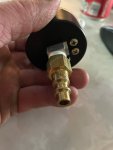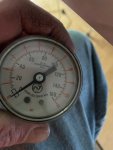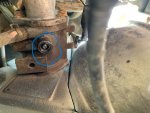Wish i had noticed this earlier. Oh well..
So, first thing is 'starts well but then runs poorly' is sort of to be expected because the computer is using fixed parameters to start the engine (ie it ignores sensors during cranking other than sampling temp and barometric pressure right before cranking). Once it's running, it runs off whatever the current sensor values are. So it's normal in this scenario to have it start normally even though it runs poorly. It does serve as evidence that the computer is seeing a bad/incorrect input, because if it was a mechanical issue it would likely have some effect at startup (ie low compression motors are harder to start, etc). This is very likely just a sensor reading issue.
According to the PDF posted back in the beginning, this thing has very few inputs. 'Engine' Temp, manifold pressure, and
maybe intake air temp (such a sensor was mentioned multiple times but noone posted any pics or links of said thing actually existing).
The symptoms are being caused by unburned fuel, aka a rich condition. The dark/fouled spark plug is a dead giveaway of that, but the other symptoms match as well. An engine that cannot burn all the fuel it is given will have some fuel going out the exhaust, which periodically ignites either because of the temperature of the exhaust manifold/piping (getting worse as it gets hotter was mentioned and correlates to this) or because of imperfect sealing of the exhaust valve letting combustion in the cylinder ignite unburned gas in the exhaust tract.
Both the temp sensor and the manifold pressure sensor could cause it to run rich.
Temp sensors are usually 'thermistors' which means resistors which change resistance with temperature. These are two wire sensors. Typically they are NTC ie Negative Temperature Coefficient thermistors which means as temp goes up, resistance goes down. This creates the side effect of a connection problem or open circuit (ie
really high resistance) appear to the computer as being 'cold'. Engines need more fuel when cold, mostly because cold fuel is harder to atomize and vaporize. So, when the computer thinks it's cold, it injects more fuel, doing the same thing a choke would do mechanically on a carburetor. SO, high resistance or open circuit on the temp sensor circuit could cause a rich issue. There
may be a resistance vs temp chart available in the service information that would allow you to test the sensor's resistance vs its temp and see if it matches, but an even easier test is this: if you unplug it while the engine is running and it doesn't run any worse, that means it
already had high resistance in that circuit, i.e bad connection or sensor is broken. It should run noticeably worse if that sensor/circuit is functional and you unplug it!
Intake air sensors are usually PTC which means as temp goes up, so does resistance. So, a temp sensor with a bad connection/open circuit would make it look hotter (
less fuel, not more, doesn't match the symptoms). But, intake air temp sensors have much lower 'authority' in the system and only cause marginal changes to fueling. Never such a big change that the spark plug fouls, no matter what the signal looks like, hot or cold. So, not the problem here even if the air temp sensor thinks it's negative 1 million degrees. It just won't cause this.
The map sensor is what's called a voltage divider. This is a 3-wire sensor. What it does is receive a 'reference voltage' from the computer, usually 5v, and then 'divide' it or split it into two voltages, one of which goes back to the computer as a signal, and the rest of the voltage gets dumped overboard to a ground wire. Map sensors in particular usually read low voltage at low pressure and high voltage at high pressure. But, if you think in terms of manifold vacuum it's opposite: High vacuum/idle = low voltage, Low vacuum/flooring it = high voltage. Usually on a 5v sensor the range of the signal is 0.5-1.2v at idle, and a max of around 4.5v at wide open throttle. Manifold pressure is the 'load' signal to the computer. You need less gas when throttle is closed and more gas when throttle is open, and manifold pressure correlates directly to how open or closed the throttle plate is.
One thing that can happen is a vacuum leak. A vacuum leak results in lower vacuum/higher pressure than would otherwise be present at that rpm and throttle opening, so it would result in too much fuel for those conditions, causing it to run rich. But, i suspect a vacuum leak is not the issue here because of one thing that is OFTEN forgotten. Vacuum leaks are powered by..vacuum! When you floor it, you don't HAVE vacuum, and you don't have a vacuum leak anymore either, for as long as you're flooring it! So if the problem doesn't noticeably improve almost to the point of going away completely when you floor it, then it isn't being caused by a vacuum leak, at least not directly. Most fuel injections can 'learn' a fuel 'trim' setting which might still apply at wide open throttle, but this is a VERY basic fuel injection system and it does not have an oxygen sensor to let it determine a 'trim' value so while not necessarily true on a car, in THIS case if you had a vacuum leak causing a problem, it would go away immediately when you floored it and sure wouldn't be costing you 10mph of top speed!
Another thing that can happen is the reference voltage can be lower than it's supposed to be because of a bad connection or resistance in the wiring. If a map sensor got 4v instead of 5v, that would skew all the readings to be lower. BUT, lower means less fuel. So it would run LEAN while flooring it, not rich! So, not a problem here. Same is true of bad connection dropping voltage in the signal wire to computer.. would result in LESS fuel, so it doesn't match the symptoms here.
Another thing that can happen is bad connection or high resistance in the ground wire. That would skew all the readings on the signal wire UP, making it run richer. This is a plausible explanation for the symptoms here.
It's also possible the sensor itself could 'break' and read wrong even though nothing is wrong with the wiring.

So in terms of easiness, i would unplug the engine temp sensor while it's running and see what changes. If NOTHING changes, that circuit is likely your problem, whether it's the sensor itself or a connector/wiring issue. If that doesn't work, you're probably going to have to get out a multimeter and see if you can find a problem with the map sensor or its wiring. Unfortunately you probably can't just unplug that one without the engine stalling, so the test methods require multimeter knowledge. About the only thing you might be able to do without a multimeter on that one, is see if the sensor comes off the throttle body. If you can leave the sensor plugged into its wiring but unplug it from
vacuum, it will immediately read as if you're flooring it. So if you can pull it out of its little vacuum hole while the engine is running, it should immediately bog out and if you're idling it will probably stall. However, if you pull it out and it DOESNT run any worse, well it wasn't doing anything helpful to begin with and now you're onto something!
Hope that helps..







